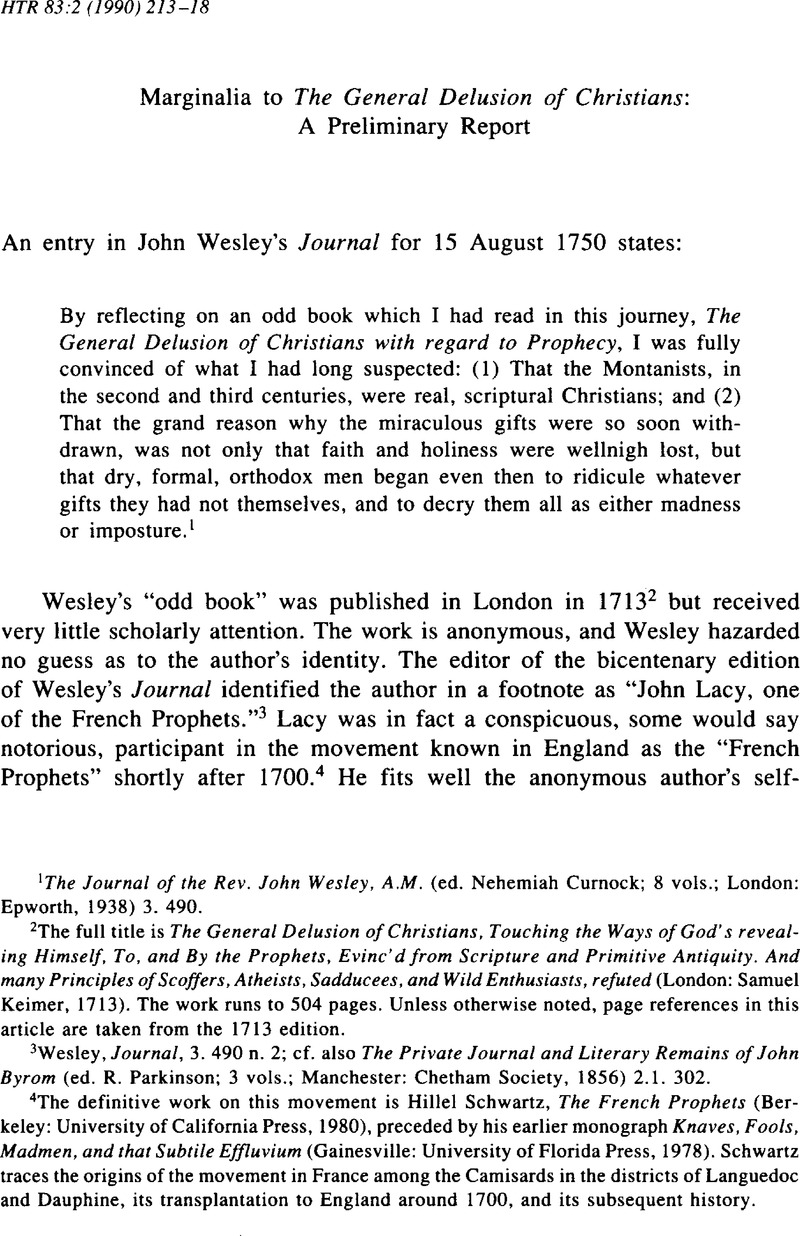No CrossRef data available.
Published online by Cambridge University Press: 10 June 2011

1 The Journal of the Rev. John Wesley, A.M. (ed. Curnock, Nehemiah; 8 vols.; London: Epworth, 1938) 3. 490Google Scholar.
2 The full title is The General Delusion of Christians, Touching the Ways of God's revealing Himself, To, and By the Prophets, Evinc'd from Scripture and Primitive Antiquity. And many Principles of Scoffers, Atheists, Sadducees, and Wild Enthusiasts, refuted (London: Samuel Keimer, 1713)Google Scholar. The work runs to 504 pages. Unless otherwise noted, page references in this article are taken from the 1713 edition.
3 , Wesley, Journal, 3Google Scholar. 490 n. 2; cf. also The Private Journal and Literary Remains of John Byrom (ed. Parkinson, R.; 3 vols.; Manchester: Chetham Society, 1856) 2.1. 302Google Scholar.
4 The definitive work on this movement is Schwartz, Hillel, The French Prophets (Berkeley: University of California Press, 1980)Google Scholar, preceded by his earlier monograph Knaves, Fools, Madmen, and that Subtile Effluvium (Gainesville: University of Florida Press, 1978)Google Scholar. Schwartz traces the origins of the movement in France among the Camisards in the districts of Languedoc and Dauphine, its transplantation to England around 1700, and its subsequent history.
5 General Delusion, 180. On Lacy, see Dictionary of National Biography (London: Smith, Elder & Co., 1892) 11. 382–83Google Scholar, and on his lack of university education, see , Schwartz, French Prophets, 228Google Scholar.
6 On Samuel Keimer and his sister, Mary Keimer, see , Schwartz, French Prophets, 298Google Scholar and passim. Keimer broke with the movement, composed a book about it, Brand pluck'd from the Burning (London, 1718)Google Scholar, came to America, and by 1723 had become Benjamin Franklin's first employer in Philadelphia! Franklin wrote of him: “He had been one of the French Prophets, and could act their enthusiastic Agitations. At this time he did not profess any particular Religion, but something of all on occasion; was very ignorant of the world, & had, as I afterwards found, a good deal of the Knave in his Composition.” See Benjamin Franklin's Memoirs: Parallel Text Edition (Berkeley/Los Angeles: University of California Press, 1949) 68Google Scholar. , Schwartz, French Prophets, also provides information on Noble (p. 138Google Scholar) and Cunninghame (p. 157).
7 The General Delusion of Christians (London: R. B. Seeley and W. Burnside, 1832)Google Scholar.
8 The volume was purchased from V. David Rodger, of Andover Antiquarian Books (now Andover Books and Prints), Andover, Massachusetts. Mr. Rodger was not able to provide information as to its provenance beyond what was evident from the book itself.
9 The inscription cites for its reference the Parkinson edition of The Private Journal and Literary Remains of John Byrom noted above (n. 3). Francis Lee, although mentioned in other sources as well (including the National Union Catalogue), is not a plausible candidate for the authorship of this work. First, he is overqualified. Far from lacking “Academick Education,” or “the Benefit of Libraries… or indeed Natural Abilities” (General Delusion, 180), Lee was a biblical and historical scholar of considerable repute (see Dictionary of National Biography, 32 [1892] 351–352). Second, Lee is the probable author of an anonymous “History of Montanism” (1709), which The General Delusion openly acknowledged as one of its sources (p. 242). See Irving, “Preface” to The General Delusion of Christians (1832) ix; also his note on p. 276 in the same edition.
10 Another example of such directions to a reader— or printer—can be seen on p. 272 (“N.B. Place the following at the End of Article V in page 278”) and p. 278 (“N.B. See what ought to have been added to this Article, thro' mistake plac'd in page 272”).
11 This opinion I have found to be shared by Hillel Schwartz, both in letter and private conversation, on examination of the marginalia.
12 For the full reference, see , Schwartz, Knaves, Fools, Madmen, 90Google Scholar. I am deeply indebted to Hillel Schwartz for providing information from his private files that revealed certain similarities of phrase between this work and the marginalia.
13 , Schwartz, French Prophets, 144–46Google Scholar.
14 , Wesley, Journal, 3. 490Google Scholar(see n. 1); Irving, “Preface” to The General Delusion of Christians (1832) ix. The poet John Byrom in 1740 judged the work “too long for my perusal; they who dispute the points which he labours to prove will hardly read such lengthened pages, and they who admit 'em may think his argumentations too diffusive. I no more doubt whether Heaven can or will give light, &c, as in former ages, than whether the sun shines as formerly; but whether this writer or his friends had such communications, or whether they were not too hasty, you who have known them better can better judge” (see above, n. 3).
15 On the latter, see most recently Grossmann, Walter, “Gruber on the Discernment of True and False Inspiration,” HTR 81 (1988) 363–87.CrossRefGoogle Scholar.
I am grateful to Dr. Grossmann for his warm encouragement and advice to one who is by no means a specialist in the eighteenth century.